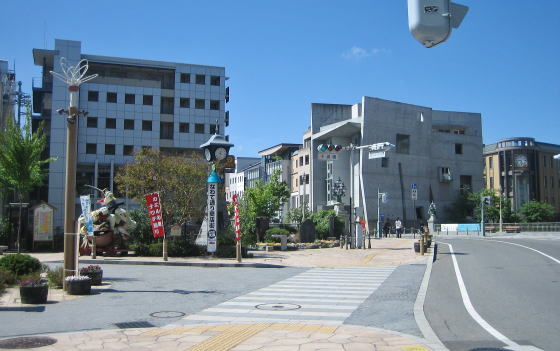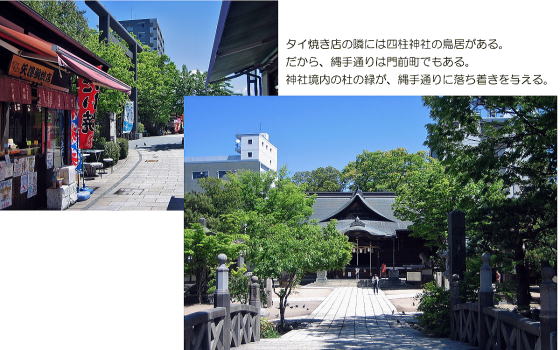|
Daimyocho street comes to end just before Metoba-gawa river, because the old downtown was bordered by Sobori, i.e. the outermost moat, which was reclaimed in Meiji Revolution. There was the southend of the castle's defence- zone.
The moat used to run in parallele with the river, divided with a narrow bank in Edo period.
Thus there was a way, narrow like a rope, on the bank on which the guard- soldiers were watching around the moat. As the rope made of paddy plants is called Nawa, the way got used to be called Nawate.

��In front of Chitosebashi bridge Daimyosho street comes to the end. The entrance to Nawate street is on the lefthand. There are a statue of giant frogs.
In those days the outermost moat turned northwards in right angle at the place called Hitotsu-bashi now. Thus Nawate is the narrow square along Metoba-gawa from Chitose-bashi to Hitotsu-bashi.
The picture above shows a view of northern foot of Chitose-bashi. The entrance of Nawate-dori street is on the left hand at which the statue of big frogs is set.
By the way, the would-be outermost moat was Sobori which encircled the larger defence-zone, involving the downtowns, of the castle. In Japanese such a zone was called Nawabari. i.e. the grand defence scheme.
The border-line rpresented by moats or river were called Mizu-nawate, i.e. the water-outline.
Then the squares along such a border-line was called Nawate. Among them, around Matsumoto Castle the square along the northern river-bank has gotten used to be called Nawate.
 |
|
|
- Map made by commitee fpr cultural assets
- Usuful for town walking�I
- defence concept of castle
- Allocation of moats
|
|
�ؑ\�H�E�ޗLj�̐S�Ɏc�镗�i�ʐ^����W
- �X���i�ρA����
�t�H�g�M�������[
- �ؑ\�H�E�ޗLj�U��
|
|
|
